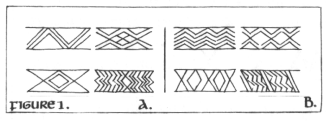|
| |
The Celtic Art Coracle volume
1 issue 11
Fig. 97: Primitive patterns from the Orkneys and Baluchstan
Language of Ornament, continued |
If we can become aware of the significance of very
rudimentary shapes- diamond, chevron, diagonal cross - and if we can begin to see number
patterns with the kind of imaginative fluidity that characterized the mind of the
pre-classical world, we may be able to see more in a page of illuminated manuscript
decoration than a superficial aesthetics allows; we may be able to penetrate to the level
of intelligible structure, rather than the representational content. 
In comparing the archaic ornaments of traditional arts, one
is struck by the universality of certain motifs such as the zigzag or the diamond pattern.
For instance, a repertory of ornament from the edge of a slab in the Orkneys (Fig.1, a) is
strikingly similar to pottery designs from the pre-Indus Valley culture of Baluchstan
(Fig.1,b). Such art is what I mean by "primitive ornament". Unfortunately, our
term, "primitive" is often used pejoratively, to mean "crude". Yet
this word properly describes values of artistic and spiritual expression that are prior to
- and more globally applied - than the parochial standards of modern art. |
|
|
![]()